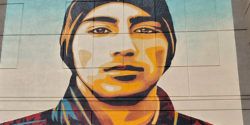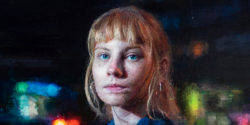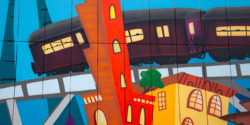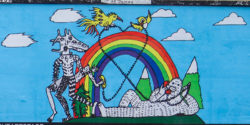NYC Graff as Historical Touchstone
International Street Art Stars
Train Writers turned Fine Artists
High Culture/Street Culture Mashups
Corporate Logos and Celebrity Collectors
If that is not enough variety for you, then you have just been spoiled by too many years living in the center of a cultural and media capital.
You’ll be glad the former photo studios, two blocks north of Manhattan’s West Side Rail Yards, are generously spacious because you’ll need headroom to contemplate the variety of messages that Chantal and Brigitte Helenbeck, Parisian gallerists, are bringing to Hell’s Kitchen for a month.
For Chantal, “The street art style and story is distinctly American. It became a global phenomenon”. Her sister Brigitte agrees and asks her to translate to the visitor, “Yes, it is about movement, and color, it is very free and for this we say it is very American.”
Amidst the flurry of 11th hour installations all over this temporary gallery, the sisters say that they see graffiti and “street art” on a continuum with other schools in contemporary art and art history in general. Chantal observes as she looks around the cavernous 12,000sf upper floor at the “Whole in the Wall” exhibition that the kids that used to be “Bad Boys” (and girls) of graffiti back in the 70’s are now warm and friendly adults who are great to work with. Better yet, many continued to develop their skills and have truly become “great studio artists”. “It is important that their talent and recognition is seen and documented with the art world,” she says.
A prime example of that observation could be Lee Quiñones, who is busily running up and down an aluminum ladder preparing a 12′ x 14′ canvas that couldn’t be more of a departure from his style back in the days of Sly Stone and Richard Nixon. A subway train writer as a teen in the 1970’s, his later exhibitions and studio work placed him in the permanent collection of the Whitney Museum. The piece he’s working on for this show speaks to a sinister, more complex time using animal symbolism so often seen in the 00’s.
Up close to this canvas, it is an imposing thick dark forest of trees where the sprouting leaves and fallen, swirling fragments are actual dollar bills. Popping forward at you from the center comes the menacing protagonist; a realistic wolf in businessman’s clothing lurking from behind a tree in horn-rimmed glasses, looking at you with a dead-eye stare.
As you talk to Mr. Quiñones, it’s easy to see that he cares deeply about his work, and he spends a great deal of time thinking about it, re-working it in his mind, and relating with it on an emotional level. The metaphor Lee had in mind this time is the children’s story “Little Red Riding Hood” and, as he points to parts of the canvas, you can see the story as it applies to any number of scams and backroom deals that clutter the business pages and Senate hearings these days. You might think of the same connection between financial crisis and the meager options for a teen in New York’s 1970’s while he describes the power brokers that created the current environment. Conspiratorially, he reveals that when the lights are out, the wolf’s eyes actually glow in the dark. He also says this piece is not finished but he’ll know when it is.
“Art is tricky, you know, you gotta look at it a lot,” the Puerto Rico-born painter says, “Then it tells you ‘Stop! Leave me alone! I’m done.’… I talk to my art, I spend time with it.”
He contrasts the life and the approach to creative work back in the “wild style” days and now; “My studio is not this big but it’s pretty big so I can step back and take a look at it. When I was painting trains 35 years ago I only had like this much space (holding his hands a yard a part) and I had this big 40 foot (long) train in front of me. …. I had no luxury of looking at it from a distance, or time. But that’s also where I get my nocturnal practice. I can actually stay up four nights without sleep, no problem. And I’ve been up three days now.” A broad smile breaks across his face as he announces this feat of endurance and commitment.
There is so much exuberance and so much to see at this show that A.D.D. seems like an excellent processing mechanism – Ramellzee’s sculpture on a highly ornate fifteenth century credenza, a French dude in a suit holding forth about the geneology of a chair, Plateus moving briskly across the floor gazing upward at the multiple canvasses and downward upon his high-gloss contorted letter sculptures, Henry Chalfants’ screen prints of miniature trains spread out on some bubble wrap, NYC’s Sharp amiably chatting with Brazillian Nunca (recently at the Tate), stencil godfather Blek le Rat sneaking outside for a cigarette where Blade is showing off the 1972 creme colored roadster he’s restoring, and, quietly, the Banksy rat glances over his shoulder.
The selections of artists for this show are not meant to be comprehensive, as is evidenced by the lack of any number of current European street artists, and almost complete lack of artists from today’s New York. What impact “Whole in the Wall” will have on current “street art” and graff movements is hard to say, but it is an often inventive way of drawing the connections and revealing the threads in a storyline that continues to be told.
Other Articles You May Like from BSA:
“He wanted to highlight youth, its beauty and diversity,” says Gautier Jordain about French stencil master Jef Aérosol for this new public mural he just completed in Evry, in the south of Paris. Je...
Starting today, for one week only, the Andes will be inside the Somerset House. Sixe Paredes. "Futurismo Ancestral" Somerset House. April 2014. London, UK (photo © Rafa Suñen) London’s spectacul...
A look inside the gallery today as we go to Hessen in Germany to see the new group exhibition mounted by the River Tales Street Art festival with the Oberhessisches Museum. Principally organized ...
It's our second day of sharing scenes from Trashplant and here we see Icy and Sot are bobbing and diving inside a colorful unnatural environment of plastic trash that is being corralled into a fenced ...
 BROOKLYN STREET ART LOVES YOU MORE EVERY DAY
BROOKLYN STREET ART LOVES YOU MORE EVERY DAY


















